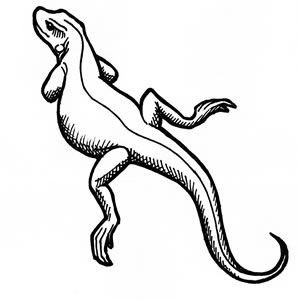270 Million Years Ago
 THE SCULPTURE represents Paliguana, a small, early predator reptile from about 270 million years ago. It is sitting on a block of chalk from Co. Antrim. This dates from the Cretaceous Period, about 100 million years ago, when the dinosaurs were at their peak.
THE SCULPTURE represents Paliguana, a small, early predator reptile from about 270 million years ago. It is sitting on a block of chalk from Co. Antrim. This dates from the Cretaceous Period, about 100 million years ago, when the dinosaurs were at their peak.
The Age of the Reptiles followed the greatest extinction of the last 600 million years, at the end of the Permian, The dinosaurs dominated the land habitats of all the continents while great marine reptiles dominated the oceans and Pterosaur reptiles dominated the sky. They were all but wiped out about 70 million years ago, when an enormous meteorite crashed into the earth, causing the extinction at the end of the Cretaceous. The first true mammals appeared about 200 million years ago, but would remain insignificant for another 130 million years.
Following the cretaceous extinction, the mammals became the dominant land animals. That will be the subject of the next station, marked by a bronze sculpture of a typical early mammal, mounted on a boulder of basalt.
AT THE END of the Carboniferous, the great equatorial coal swamps dried up. This greatly reduced the habitat of the amphibians, which constitute a relatively minor part of the fauna today, represented by frogs, toads, newts and salamanders.
The reptiles first appeared in the late Carboniferous, where they made relatively little impact in the great swamp forests. They had two advantages – waterproof skins and, most importantly, amniote eggs with an outer shell, which could be laid on dry land. In the drier conditions of the Permian, they rapidly diversified, dominated ultimately by large Therapsida, the mammal like reptiles, ancestors of the true mammals. The Therapsida were almost wiped out by the great End-Permian extinction, which paved the way for the dominance of the reptiles, which reduced the mammals to a handful of tiny skulking species.
No rocks containing dinosaur bones have been found in Ireland, the only rocks from the period being chalk, which is formed from the shells of tiny plankton falling to the bottom of the sea.